AIA - ICTSUS601: Sustainability Briefing Report and Energy Audit
VerifiedAdded on 2022/08/22
|7
|1399
|27
Report
AI Summary
This report presents a comprehensive sustainability briefing and energy audit for Document Nation, an Australian document editing company. The report begins with a series of written questions addressing key concepts in ICT sustainability, including energy-efficient equipment, relevant legislation (EPBC Act), and industry standards (AS/NZS 3598:2014). It emphasizes the triple constraint (planet, people, portfolio), the importance of WHS, and methods for calculating CO2 emissions. The report then outlines the steps for developing and implementing a sustainability policy, including stakeholder consultation and performance indicators. The assessment also identifies tools for sustainability improvements within an ICT business, such as quality management plans and payback period analysis. The systems review analyzes Document Nation's current ICT infrastructure, including its energy consumption and carbon footprint. The report recommends the implementation of Virtual Desktop Infrastructure (VDI) using VirtualBox to reduce energy usage and associated costs, providing detailed calculations of potential savings, payback period, and CO2 emission reductions. The report recommends the implementation of VDI and provides a detailed cost-benefit analysis and recommendations for future sustainability initiatives, including thin clients and hybrid cloud computing.

ICT Sustainability Briefing Report
Name
Institution
Date
Name
Institution
Date
Paraphrase This Document
Need a fresh take? Get an instant paraphrase of this document with our AI Paraphraser
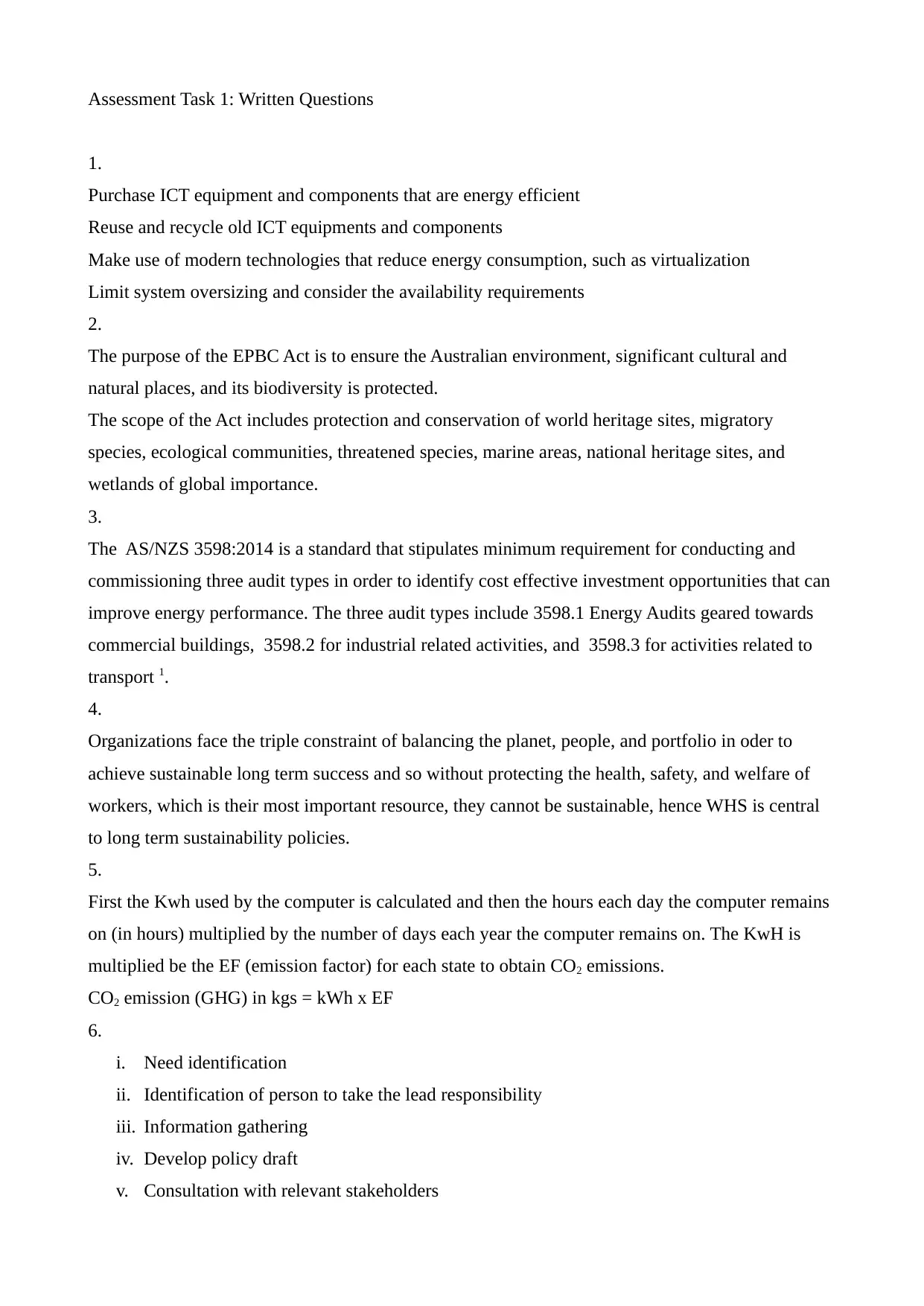
Assessment Task 1: Written Questions
1.
Purchase ICT equipment and components that are energy efficient
Reuse and recycle old ICT equipments and components
Make use of modern technologies that reduce energy consumption, such as virtualization
Limit system oversizing and consider the availability requirements
2.
The purpose of the EPBC Act is to ensure the Australian environment, significant cultural and
natural places, and its biodiversity is protected.
The scope of the Act includes protection and conservation of world heritage sites, migratory
species, ecological communities, threatened species, marine areas, national heritage sites, and
wetlands of global importance.
3.
The AS/NZS 3598:2014 is a standard that stipulates minimum requirement for conducting and
commissioning three audit types in order to identify cost effective investment opportunities that can
improve energy performance. The three audit types include 3598.1 Energy Audits geared towards
commercial buildings, 3598.2 for industrial related activities, and 3598.3 for activities related to
transport 1.
4.
Organizations face the triple constraint of balancing the planet, people, and portfolio in oder to
achieve sustainable long term success and so without protecting the health, safety, and welfare of
workers, which is their most important resource, they cannot be sustainable, hence WHS is central
to long term sustainability policies.
5.
First the Kwh used by the computer is calculated and then the hours each day the computer remains
on (in hours) multiplied by the number of days each year the computer remains on. The KwH is
multiplied be the EF (emission factor) for each state to obtain CO2 emissions.
CO2 emission (GHG) in kgs = kWh x EF
6.
i. Need identification
ii. Identification of person to take the lead responsibility
iii. Information gathering
iv. Develop policy draft
v. Consultation with relevant stakeholders
1.
Purchase ICT equipment and components that are energy efficient
Reuse and recycle old ICT equipments and components
Make use of modern technologies that reduce energy consumption, such as virtualization
Limit system oversizing and consider the availability requirements
2.
The purpose of the EPBC Act is to ensure the Australian environment, significant cultural and
natural places, and its biodiversity is protected.
The scope of the Act includes protection and conservation of world heritage sites, migratory
species, ecological communities, threatened species, marine areas, national heritage sites, and
wetlands of global importance.
3.
The AS/NZS 3598:2014 is a standard that stipulates minimum requirement for conducting and
commissioning three audit types in order to identify cost effective investment opportunities that can
improve energy performance. The three audit types include 3598.1 Energy Audits geared towards
commercial buildings, 3598.2 for industrial related activities, and 3598.3 for activities related to
transport 1.
4.
Organizations face the triple constraint of balancing the planet, people, and portfolio in oder to
achieve sustainable long term success and so without protecting the health, safety, and welfare of
workers, which is their most important resource, they cannot be sustainable, hence WHS is central
to long term sustainability policies.
5.
First the Kwh used by the computer is calculated and then the hours each day the computer remains
on (in hours) multiplied by the number of days each year the computer remains on. The KwH is
multiplied be the EF (emission factor) for each state to obtain CO2 emissions.
CO2 emission (GHG) in kgs = kWh x EF
6.
i. Need identification
ii. Identification of person to take the lead responsibility
iii. Information gathering
iv. Develop policy draft
v. Consultation with relevant stakeholders
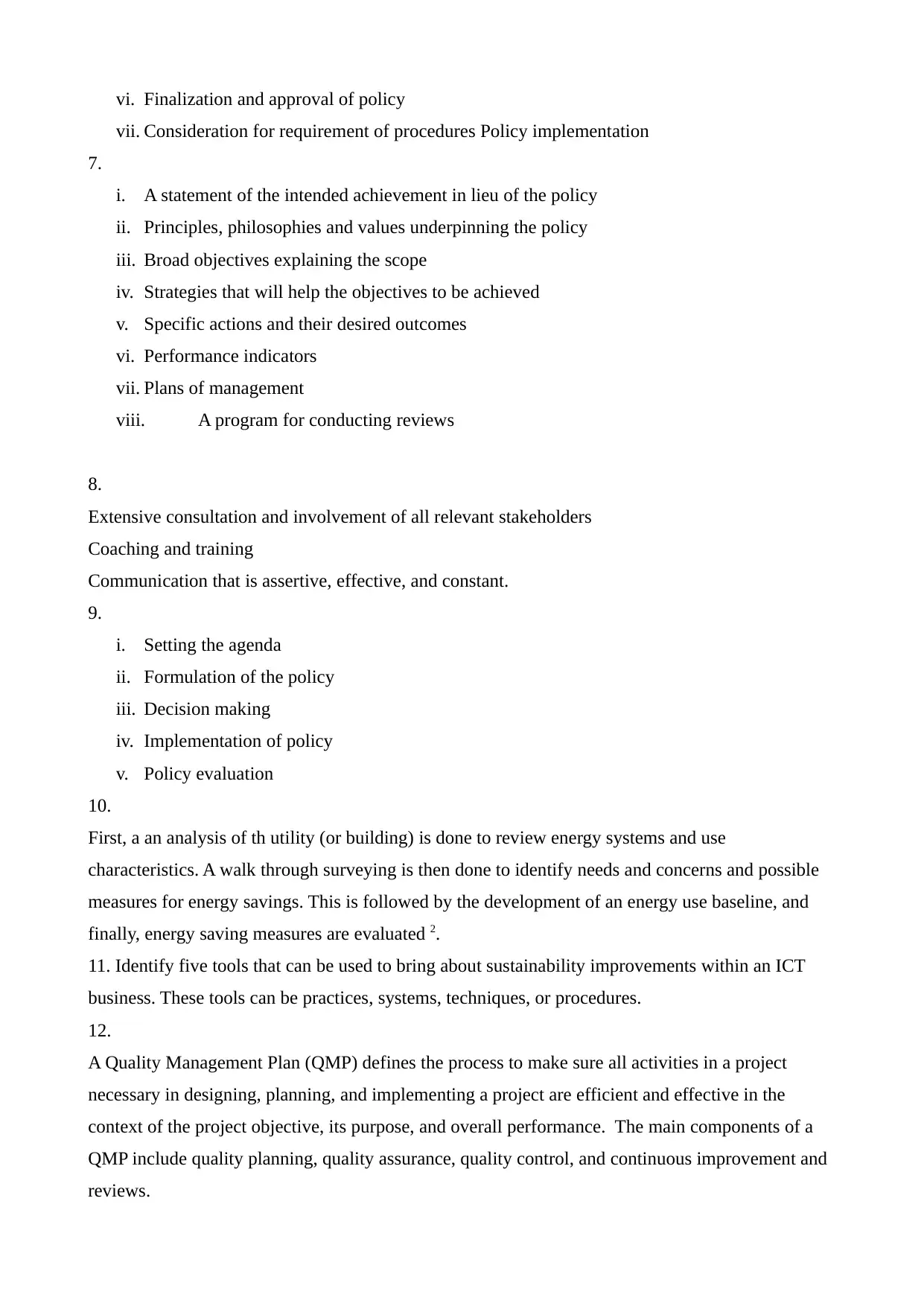
vi. Finalization and approval of policy
vii. Consideration for requirement of procedures Policy implementation
7.
i. A statement of the intended achievement in lieu of the policy
ii. Principles, philosophies and values underpinning the policy
iii. Broad objectives explaining the scope
iv. Strategies that will help the objectives to be achieved
v. Specific actions and their desired outcomes
vi. Performance indicators
vii. Plans of management
viii. A program for conducting reviews
8.
Extensive consultation and involvement of all relevant stakeholders
Coaching and training
Communication that is assertive, effective, and constant.
9.
i. Setting the agenda
ii. Formulation of the policy
iii. Decision making
iv. Implementation of policy
v. Policy evaluation
10.
First, a an analysis of th utility (or building) is done to review energy systems and use
characteristics. A walk through surveying is then done to identify needs and concerns and possible
measures for energy savings. This is followed by the development of an energy use baseline, and
finally, energy saving measures are evaluated 2.
11. Identify five tools that can be used to bring about sustainability improvements within an ICT
business. These tools can be practices, systems, techniques, or procedures.
12.
A Quality Management Plan (QMP) defines the process to make sure all activities in a project
necessary in designing, planning, and implementing a project are efficient and effective in the
context of the project objective, its purpose, and overall performance. The main components of a
QMP include quality planning, quality assurance, quality control, and continuous improvement and
reviews.
vii. Consideration for requirement of procedures Policy implementation
7.
i. A statement of the intended achievement in lieu of the policy
ii. Principles, philosophies and values underpinning the policy
iii. Broad objectives explaining the scope
iv. Strategies that will help the objectives to be achieved
v. Specific actions and their desired outcomes
vi. Performance indicators
vii. Plans of management
viii. A program for conducting reviews
8.
Extensive consultation and involvement of all relevant stakeholders
Coaching and training
Communication that is assertive, effective, and constant.
9.
i. Setting the agenda
ii. Formulation of the policy
iii. Decision making
iv. Implementation of policy
v. Policy evaluation
10.
First, a an analysis of th utility (or building) is done to review energy systems and use
characteristics. A walk through surveying is then done to identify needs and concerns and possible
measures for energy savings. This is followed by the development of an energy use baseline, and
finally, energy saving measures are evaluated 2.
11. Identify five tools that can be used to bring about sustainability improvements within an ICT
business. These tools can be practices, systems, techniques, or procedures.
12.
A Quality Management Plan (QMP) defines the process to make sure all activities in a project
necessary in designing, planning, and implementing a project are efficient and effective in the
context of the project objective, its purpose, and overall performance. The main components of a
QMP include quality planning, quality assurance, quality control, and continuous improvement and
reviews.
⊘ This is a preview!⊘
Do you want full access?
Subscribe today to unlock all pages.

Trusted by 1+ million students worldwide
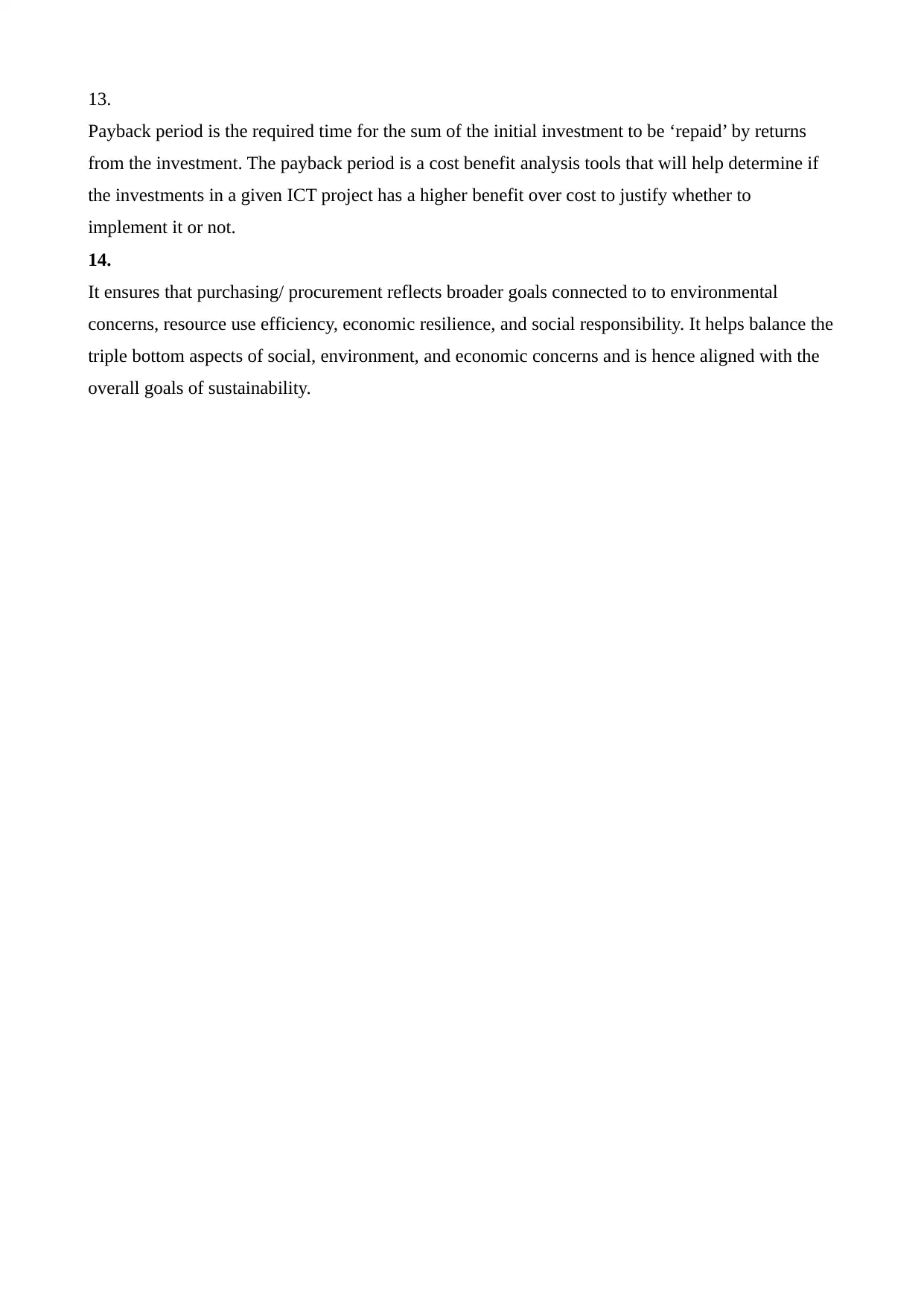
13.
Payback period is the required time for the sum of the initial investment to be ‘repaid’ by returns
from the investment. The payback period is a cost benefit analysis tools that will help determine if
the investments in a given ICT project has a higher benefit over cost to justify whether to
implement it or not.
14.
It ensures that purchasing/ procurement reflects broader goals connected to to environmental
concerns, resource use efficiency, economic resilience, and social responsibility. It helps balance the
triple bottom aspects of social, environment, and economic concerns and is hence aligned with the
overall goals of sustainability.
Payback period is the required time for the sum of the initial investment to be ‘repaid’ by returns
from the investment. The payback period is a cost benefit analysis tools that will help determine if
the investments in a given ICT project has a higher benefit over cost to justify whether to
implement it or not.
14.
It ensures that purchasing/ procurement reflects broader goals connected to to environmental
concerns, resource use efficiency, economic resilience, and social responsibility. It helps balance the
triple bottom aspects of social, environment, and economic concerns and is hence aligned with the
overall goals of sustainability.
Paraphrase This Document
Need a fresh take? Get an instant paraphrase of this document with our AI Paraphraser
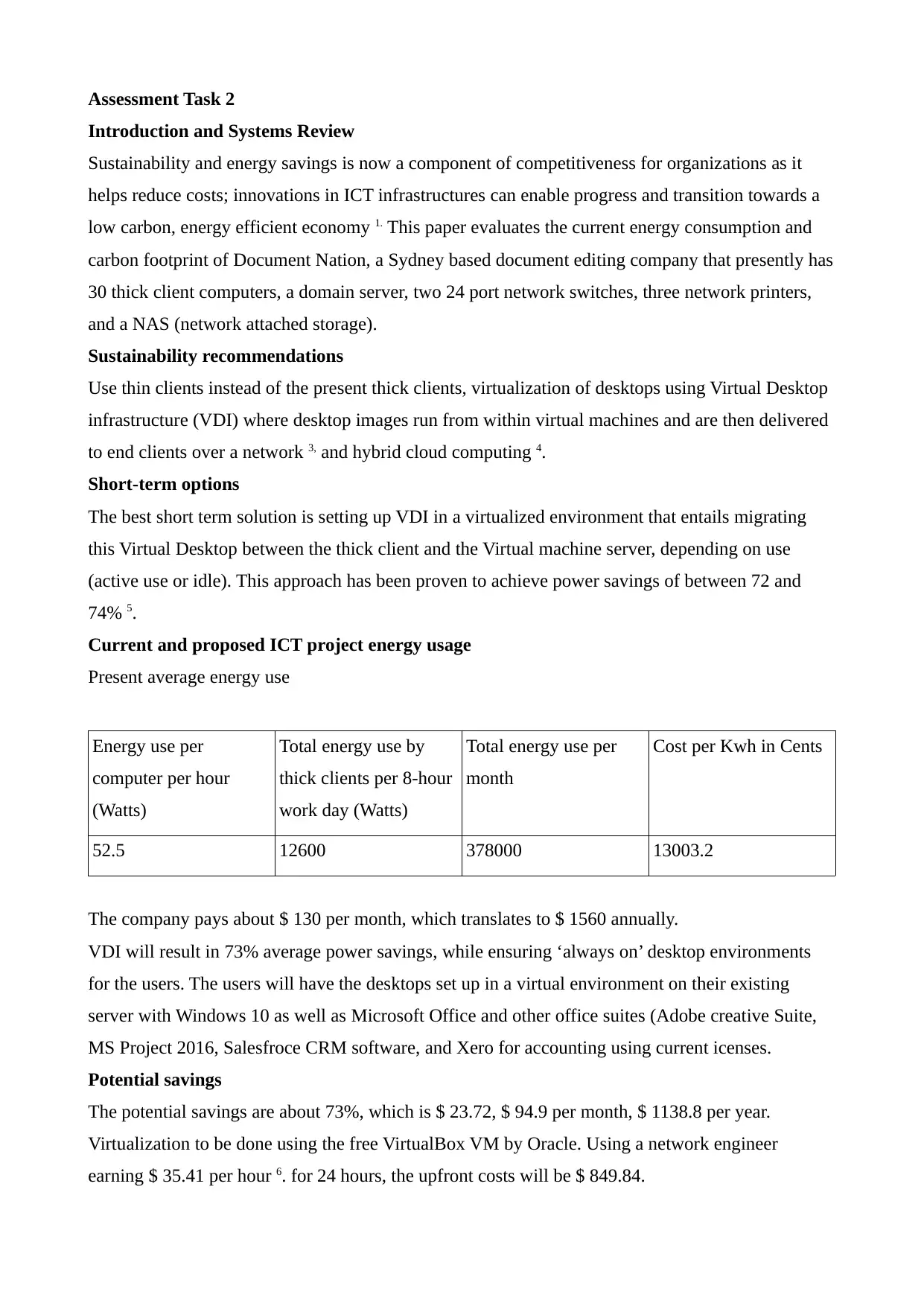
Assessment Task 2
Introduction and Systems Review
Sustainability and energy savings is now a component of competitiveness for organizations as it
helps reduce costs; innovations in ICT infrastructures can enable progress and transition towards a
low carbon, energy efficient economy 1. This paper evaluates the current energy consumption and
carbon footprint of Document Nation, a Sydney based document editing company that presently has
30 thick client computers, a domain server, two 24 port network switches, three network printers,
and a NAS (network attached storage).
Sustainability recommendations
Use thin clients instead of the present thick clients, virtualization of desktops using Virtual Desktop
infrastructure (VDI) where desktop images run from within virtual machines and are then delivered
to end clients over a network 3, and hybrid cloud computing 4.
Short-term options
The best short term solution is setting up VDI in a virtualized environment that entails migrating
this Virtual Desktop between the thick client and the Virtual machine server, depending on use
(active use or idle). This approach has been proven to achieve power savings of between 72 and
74% 5.
Current and proposed ICT project energy usage
Present average energy use
Energy use per
computer per hour
(Watts)
Total energy use by
thick clients per 8-hour
work day (Watts)
Total energy use per
month
Cost per Kwh in Cents
52.5 12600 378000 13003.2
The company pays about $ 130 per month, which translates to $ 1560 annually.
VDI will result in 73% average power savings, while ensuring ‘always on’ desktop environments
for the users. The users will have the desktops set up in a virtual environment on their existing
server with Windows 10 as well as Microsoft Office and other office suites (Adobe creative Suite,
MS Project 2016, Salesfroce CRM software, and Xero for accounting using current icenses.
Potential savings
The potential savings are about 73%, which is $ 23.72, $ 94.9 per month, $ 1138.8 per year.
Virtualization to be done using the free VirtualBox VM by Oracle. Using a network engineer
earning $ 35.41 per hour 6. for 24 hours, the upfront costs will be $ 849.84.
Introduction and Systems Review
Sustainability and energy savings is now a component of competitiveness for organizations as it
helps reduce costs; innovations in ICT infrastructures can enable progress and transition towards a
low carbon, energy efficient economy 1. This paper evaluates the current energy consumption and
carbon footprint of Document Nation, a Sydney based document editing company that presently has
30 thick client computers, a domain server, two 24 port network switches, three network printers,
and a NAS (network attached storage).
Sustainability recommendations
Use thin clients instead of the present thick clients, virtualization of desktops using Virtual Desktop
infrastructure (VDI) where desktop images run from within virtual machines and are then delivered
to end clients over a network 3, and hybrid cloud computing 4.
Short-term options
The best short term solution is setting up VDI in a virtualized environment that entails migrating
this Virtual Desktop between the thick client and the Virtual machine server, depending on use
(active use or idle). This approach has been proven to achieve power savings of between 72 and
74% 5.
Current and proposed ICT project energy usage
Present average energy use
Energy use per
computer per hour
(Watts)
Total energy use by
thick clients per 8-hour
work day (Watts)
Total energy use per
month
Cost per Kwh in Cents
52.5 12600 378000 13003.2
The company pays about $ 130 per month, which translates to $ 1560 annually.
VDI will result in 73% average power savings, while ensuring ‘always on’ desktop environments
for the users. The users will have the desktops set up in a virtual environment on their existing
server with Windows 10 as well as Microsoft Office and other office suites (Adobe creative Suite,
MS Project 2016, Salesfroce CRM software, and Xero for accounting using current icenses.
Potential savings
The potential savings are about 73%, which is $ 23.72, $ 94.9 per month, $ 1138.8 per year.
Virtualization to be done using the free VirtualBox VM by Oracle. Using a network engineer
earning $ 35.41 per hour 6. for 24 hours, the upfront costs will be $ 849.84.
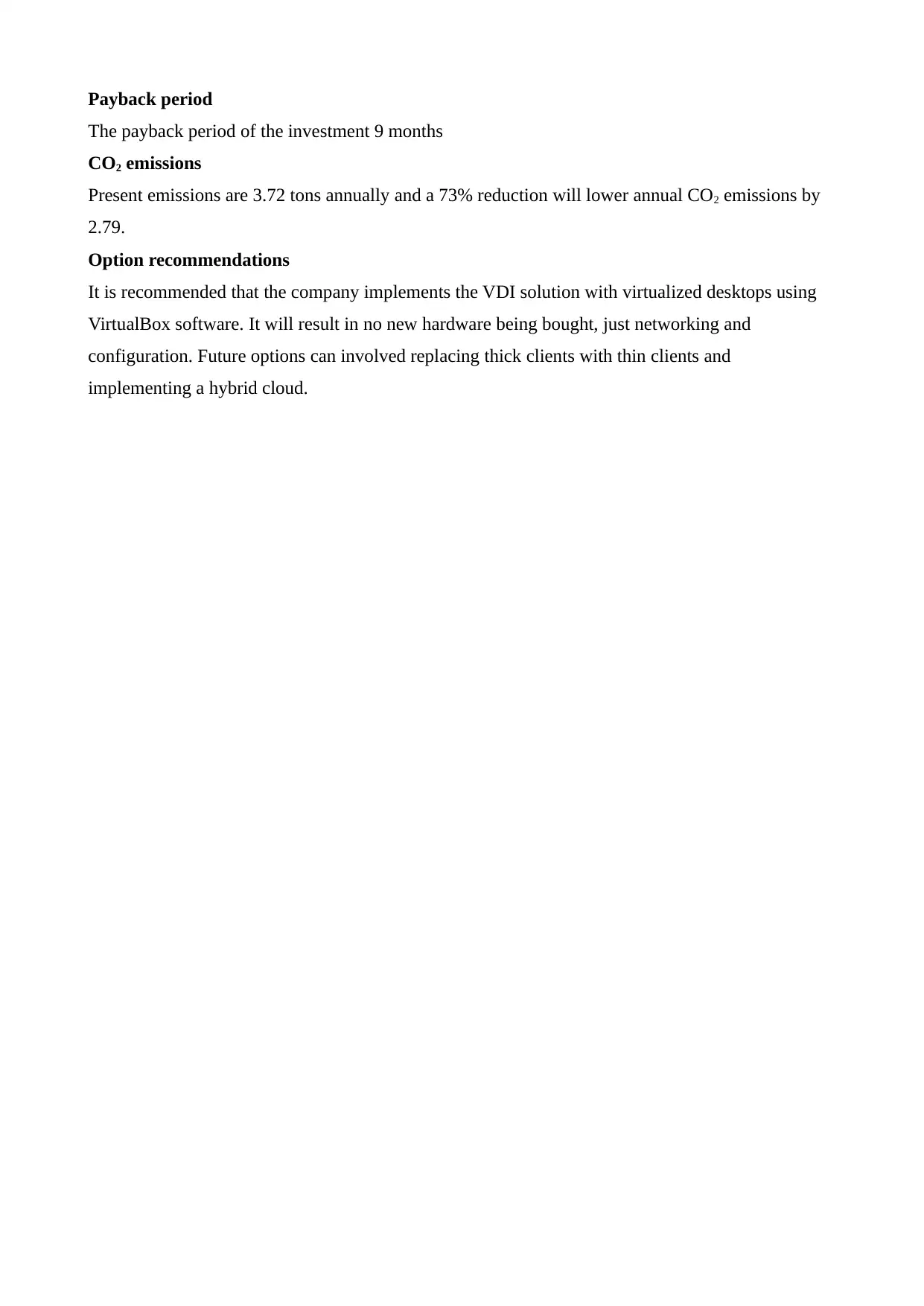
Payback period
The payback period of the investment 9 months
CO2 emissions
Present emissions are 3.72 tons annually and a 73% reduction will lower annual CO2 emissions by
2.79.
Option recommendations
It is recommended that the company implements the VDI solution with virtualized desktops using
VirtualBox software. It will result in no new hardware being bought, just networking and
configuration. Future options can involved replacing thick clients with thin clients and
implementing a hybrid cloud.
The payback period of the investment 9 months
CO2 emissions
Present emissions are 3.72 tons annually and a 73% reduction will lower annual CO2 emissions by
2.79.
Option recommendations
It is recommended that the company implements the VDI solution with virtualized desktops using
VirtualBox software. It will result in no new hardware being bought, just networking and
configuration. Future options can involved replacing thick clients with thin clients and
implementing a hybrid cloud.
⊘ This is a preview!⊘
Do you want full access?
Subscribe today to unlock all pages.

Trusted by 1+ million students worldwide
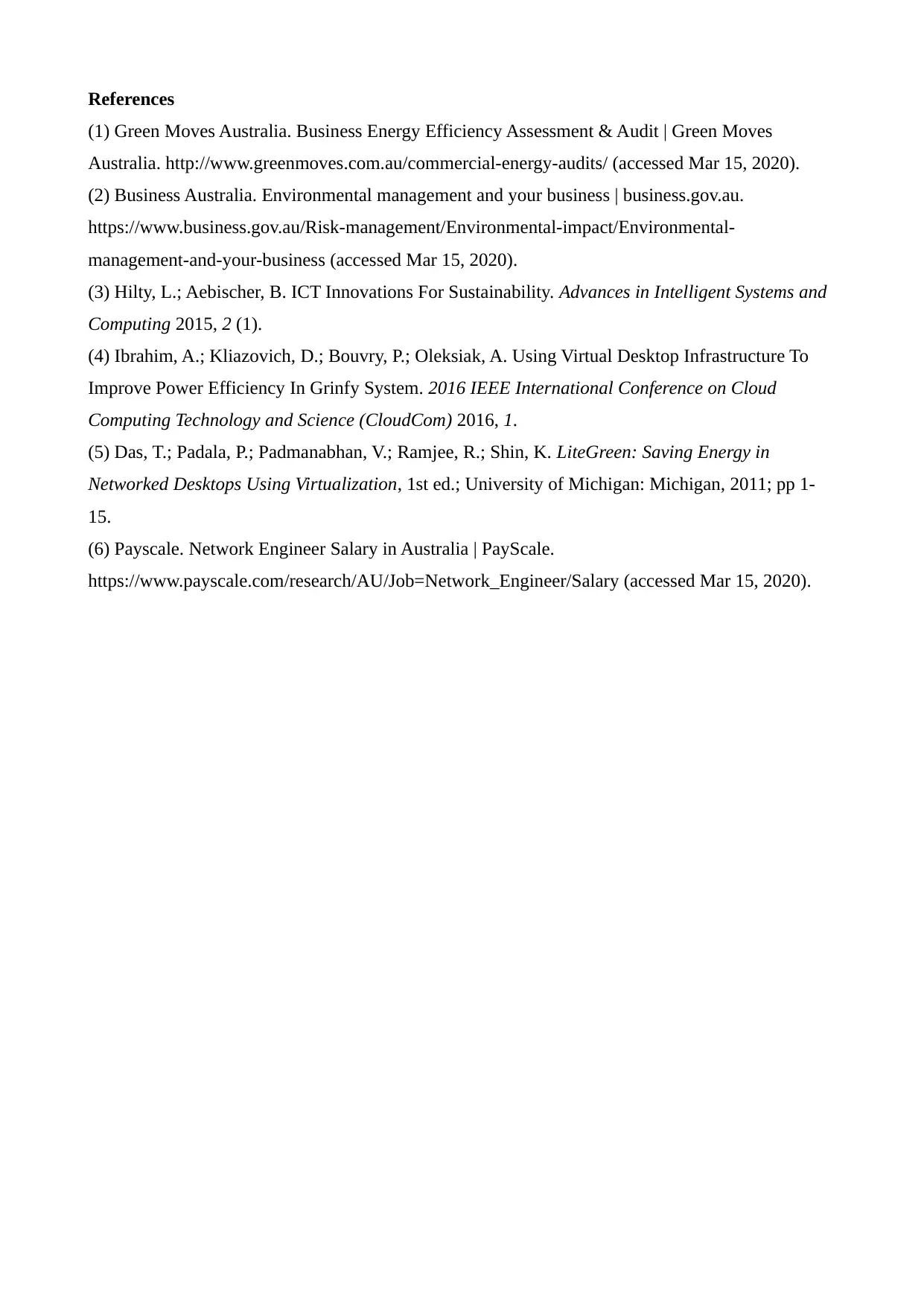
References
(1) Green Moves Australia. Business Energy Efficiency Assessment & Audit | Green Moves
Australia. http://www.greenmoves.com.au/commercial-energy-audits/ (accessed Mar 15, 2020).
(2) Business Australia. Environmental management and your business | business.gov.au.
https://www.business.gov.au/Risk-management/Environmental-impact/Environmental-
management-and-your-business (accessed Mar 15, 2020).
(3) Hilty, L.; Aebischer, B. ICT Innovations For Sustainability. Advances in Intelligent Systems and
Computing 2015, 2 (1).
(4) Ibrahim, A.; Kliazovich, D.; Bouvry, P.; Oleksiak, A. Using Virtual Desktop Infrastructure To
Improve Power Efficiency In Grinfy System. 2016 IEEE International Conference on Cloud
Computing Technology and Science (CloudCom) 2016, 1.
(5) Das, T.; Padala, P.; Padmanabhan, V.; Ramjee, R.; Shin, K. LiteGreen: Saving Energy in
Networked Desktops Using Virtualization, 1st ed.; University of Michigan: Michigan, 2011; pp 1-
15.
(6) Payscale. Network Engineer Salary in Australia | PayScale.
https://www.payscale.com/research/AU/Job=Network_Engineer/Salary (accessed Mar 15, 2020).
(1) Green Moves Australia. Business Energy Efficiency Assessment & Audit | Green Moves
Australia. http://www.greenmoves.com.au/commercial-energy-audits/ (accessed Mar 15, 2020).
(2) Business Australia. Environmental management and your business | business.gov.au.
https://www.business.gov.au/Risk-management/Environmental-impact/Environmental-
management-and-your-business (accessed Mar 15, 2020).
(3) Hilty, L.; Aebischer, B. ICT Innovations For Sustainability. Advances in Intelligent Systems and
Computing 2015, 2 (1).
(4) Ibrahim, A.; Kliazovich, D.; Bouvry, P.; Oleksiak, A. Using Virtual Desktop Infrastructure To
Improve Power Efficiency In Grinfy System. 2016 IEEE International Conference on Cloud
Computing Technology and Science (CloudCom) 2016, 1.
(5) Das, T.; Padala, P.; Padmanabhan, V.; Ramjee, R.; Shin, K. LiteGreen: Saving Energy in
Networked Desktops Using Virtualization, 1st ed.; University of Michigan: Michigan, 2011; pp 1-
15.
(6) Payscale. Network Engineer Salary in Australia | PayScale.
https://www.payscale.com/research/AU/Job=Network_Engineer/Salary (accessed Mar 15, 2020).
1 out of 7
Related Documents
Your All-in-One AI-Powered Toolkit for Academic Success.
+13062052269
info@desklib.com
Available 24*7 on WhatsApp / Email
![[object Object]](/_next/static/media/star-bottom.7253800d.svg)
Unlock your academic potential
Copyright © 2020–2025 A2Z Services. All Rights Reserved. Developed and managed by ZUCOL.





